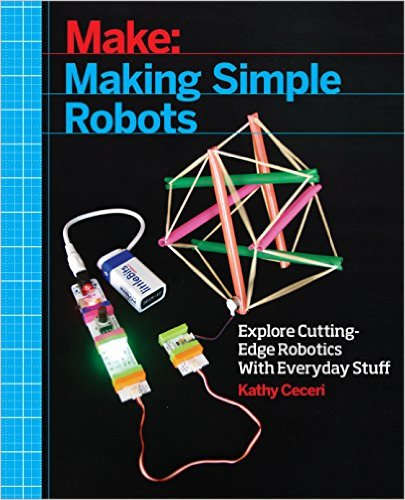| Making Simple Robots |
Author: Kathy Cerceri The subtitle of this book is: Exploring Cutting-Edge Robotics with Everyday Stuff. How can "cutting-edge" and "everyday stuff" fit together? This is not the book you might be expecting if you interpret the title to mean "robot" as in electronics and heavy actuators. In fact you might not think that the book is about robots at all unless you have a very wide interpretation of the term. This is not to say that this book is a waste of paper - far from it. It really is about cutting-edge developments in robotics, but it concentrates on novel movement and construction techniques and this tends to give the book more a "crafts" than technology feel to it. Chapter 1 starts out with a look at building robots out of "interesting" materials. The first project is "actuated" paper. Take some memory wire and embed it in paper. When a current is passed though the wire it changes shape and takes the paper with it. This is cutting-edge and very simple. I really don't think that SMA wire is everyday stuff but you can get it quite easily. Next we have an inflatable robot - not quite the big "ride on" inflatables that really the cutting-edge but some small balloon based muscles. There is lots of discussion on what you might do to extend the project or how to modify it to use different components. Chapter 2 is about movement - a "tensegrity" (a term coined by architect Buckminster Fuller that combines tension and integrity) robot using straws and elastic and some components from a LittleBits kit. The LittleBits parts aren't cheap, but they are easy to use. Some readers are likely to be disappointed that the opportunity wasn't taken to build the electronics from basic components, but this isn't that sort of book. Next we have a build for a wheg based robot - whegs are a cross between a wheel and a leg. The big problem with this project is you need a 3D printer, but as the book points out there are places that will print things for you. The project is mostly about how to use a 3D printer and how you put it together to make a robot platform is left mostly up to you.
The next chapter takes us into the idea of BEAM robots - robots made out of leftover parts and repurposed circuits with a vague "organic" feel to them. The first project is a swarm of dumb vibrobots. For this you need some vibration motors of the sort you find in mobile phones. The next project is a solar BEAM wobblebot - and this really is a soldering job. The project could be made from scratch but a kit is used in the photos - there is a complete list of parts however. This is the most electronics oriented of all the projects. In Chapter 4 we move into software and learn some Scratch. The last part of the chapter is about the uncanny valley and attempts to demonstrate by a very un-lifelike face model. Chapter 5 is called Fun, Artsy Robots, and if you are a hardline engineer you might have thought of the earlier robots as being mainly artsy. The first project is a plotter using LittleBits modules and servos. Next we have a project using an AdaFruit Gemma to create a cloth-based robot. The big problem with this project is that the program is just presented as page after page of listings without enough guidance on what it is all about. If you are a complete beginner with the Arduino then I'm not sure what you are going to make of it all. This is the most ambitious of the projects and it is also the one that might cause the most problems.
This isn't a book that you can follow with just things you find around the house. You are going to have to buy special components and this isn't unreasonable. Despite the use of some electronics, and even an Arduino, the book doesn't really explain these devices enough to help the beginner. As long as you know what you are buying, this is a good and enjoyable book. If just one of the projects sparks an interest in making novel robots then it is a good investment. To keep up with our coverage of books for programmers, follow @bookwatchiprog on Twitter or subscribe to I Programmer's Books RSS feed for each day's new addition to Book Watch and for new reviews.
|
|||
| Last Updated ( Friday, 05 October 2018 ) |


